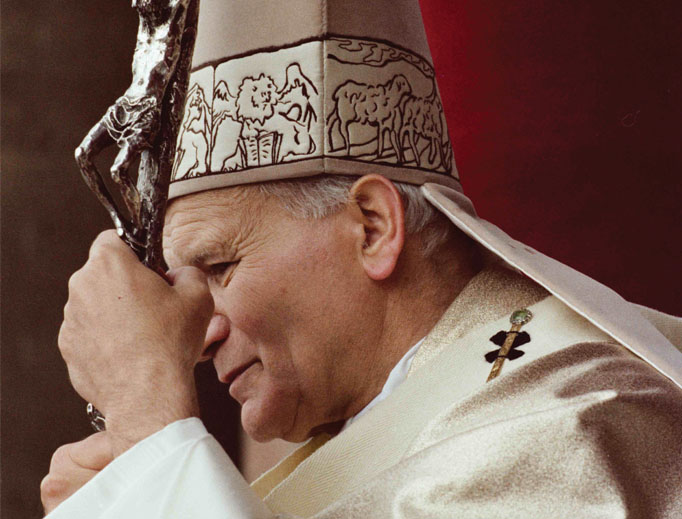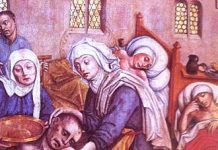MESSAGE OF THE HOLY FATHER
TO THE CAMILLIAN FAMILY ON THE 450TH ANNIVERSARY
OF THEIR FOUNDER’S BIRTH
To Fr Angelo Brusco
Superior General of the Order of Clerics
Regular Servants of the Sick (Camillians)
- The joy that accompanies the celebration of the Great Jubilee of the Incarnation has a special resonance for the Camillian family, which is preparing to celebrate the 450th anniversary of the birth of St Camillus de Lellis on 25 May 1550 in Bucchianico. I gladly join in the thanksgiving of this order which he founded, as well as that of the Congregation of the Servants of the Sick of St Camillus, the Daughters of St Camillus, the Secular Institutes of Missionaries of the Sick Christ Our Hope, of the Kamillianische Schwestern and of the Lay Camillian Family, born later of the charism and spirituality of this great saint from the Abruzzi.
This anniversary has particular importance for the world of health care and suffering, not only because of the generous commitment to the sick of St Camillus’ sons, but especially because your founder was proclaimed patron of the sick and of hospitals in 1886 by Pope Leo XIII, of health-care personnel in 1930 by Pope Pius XI and of the Health Services of the Italian Military by Paul VI in 1974.
The fact that this celebration coincides with the Jubilee Year also gives it a very special significance, because the human and spiritual journey of St Camillus took place in the context of the great Jubilee events, from which he drew a deep desire for conversion and generous intentions to serve Christ in his sick brethren. Born in the Holy Year 1550, he had a conversion experience in 1575 and, during the Jubilee of 1600, completed his guidelines for living the charism of merciful love for the sick. These coincidences are a special invitation for this order and the religious families associated with it to accept the graces of the Great Jubilee and of their founder’s anniversary as an occasion for reneweing their fidelity to the Lord and to the Camillian charism.
- St Camillus de Lellis lived in a particularly complex time, in which a deep longing for holiness but also a tenacious resistance to Gospel-inspired living were widespread. With his rich personality and his witness of charity, he offered the society of his time valuable encouragement for spiritual renewal, thus contributing in an original way to the project of Church reform promoted by the Council of Trent. His life, under the influence of the Spirit, appears as a marvellous story of the love of God, the Creator and Redeemer, who reveals in a special wayhis tender compassion as the physician of souls and bodies.
His work at the service of the suffering appears as an authentic school. Pope Benedict XIV recognized the newness of its service given with love and skill, that is, combining scientific and technical knowledge, actions and attitudes filled with that caring and sympathetic humanity which is rooted in the Gospel. In his Disposizioni e modi che si devono seguire negli ospedali per servire i poveri infermi, which he wrote in 1584, he offers insights and advice most of which would be adopted by the science of nursing in our day. He maintained that it was important to consider all the dimensions of the sick person with attention and respect, from the physical to the emotional, from the social to the spiritual. In a well-known passage of his Rule he invites us to ask the Lord for the grace “of motherly affection for our neighbour”, so that “body and soul can be served with true love. Indeed, with God’s grace we want to serve the sick with the affection that a loving mother is wont to show her sick only child”.
However, it is especially by his example that St Camillus teaches us how to make the service of the sick an intense experience of God, leading us to seek the Lord constantly in prayer and the sacraments. His life seems to repeat the action of the woman described in St John’s Gospel (cf. 12:3). He too anoints the feet of Jesus, present in the suffering, with the precious ointment of merciful charity, filling the whole Church and society with the fragrance of his apostolic zeal and spirituality. Today his witness remains a forceful call to love Christ present in our brethren who are burdened by illness.
- Down the centuries this call, heard by so many generous souls, has amply demonstrated the fruitfulness of Camillus de Lellis’ charism. Thus this order, fulfilling the promise of its holy founder’s boundless love, has spread its branches to the five continents, extending itself in the last 50 years to 20 new, mostly developing, countries. Recently, in response to the wishes of Peter’s Successor, it has made the cross of St Camillus shine in Armenia and Georgia, proclaiming the Gospel of charity to the sick among those peoples oppressed for so many years by regimes hostile to the Christian religion.
And what can we say of those who embraced St Camillus’ ideals and way of life and reached the heights of holiness? Here I would like to recall in particular the chosen members of the great Camillian family whom I myself had the joy of raising to the honour of the altars: Enrico Rebuschini, a religious of this order; Giuseppina Vannini, foundress of the Daughters of St Camillus, Maria Domenica Brun Barbantini, foundress of the Servants of the Sick of St Camillus.
At the same time, however, I cannot forget the Camillian religious who down the centuries “have given their lives in service to victims of contagious diseases, confirming the truth that dedication to the point of heroism belongs to the prophetic nature of the consecrated life” (Vita consecrata, n. 83). How can we not see in this flourishing holiness a confirmation of the validity of the Camillian charism as a way to the perfection of charity?
(To continue reading, please see here)











